I’m a huge fan of the Queen Mary 2. My Dad and I did a transatlantic crossing on her not too long after she entered service, and it remains one of my all-time favorite vacations. The QM2 is a splendid ship. Her interiors are beautiful, the food is first-rate, and the atmosphere on board is pleasantly relaxed. She also retains a sense of intimacy despite the fact that she’s the largest ocean liner ever built. But after twelve years of service, Cunard has decided that it’s time for a change. Next month, she’ll travel to the famous German shipyard Blohm + Voss for a month-long refit.
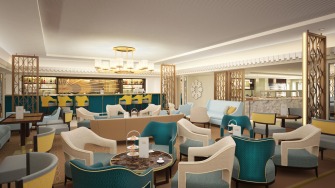
One of the biggest changes is that the Winter Garden will be replaced with the Carinthia Lounge. For me, it’s a sad development. The Winter Garden was one of my favorite public rooms on the QM2, though I realize that’s a minority opinion. Critics and passengers alike tended to view it as the weakest of the ship’s public rooms. Many saw it as kitschy, and they had a point. Originally, the Winter Garden featured a mural of tropical birds sitting amidst a backdrop of generic jungle foliage and an equally leafy carpet, and they both looked like something from Blanche Devereaux’s bedroom on The Golden Girls (sadly, the mural seems to have been replaced with a frosted-glass version of the same motif, as seen here). There was also wicker. Lots and lots of wicker.
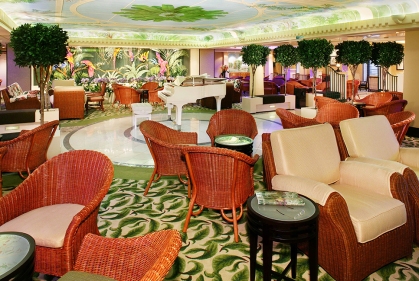
Nevertheless, the Winter Garden has a place in my heart. It was usually fairly empty, and it was a great place to have a drink since there was a bar right there in the room. I also liked the fact that the Winter Garden had a sense of history behind it. Winter gardens, verandah cafes, and the like were fixtures on transatlantic liners throughout the golden age of ocean travel. The following photos come from a 1920s Cunard brochure in my collection:
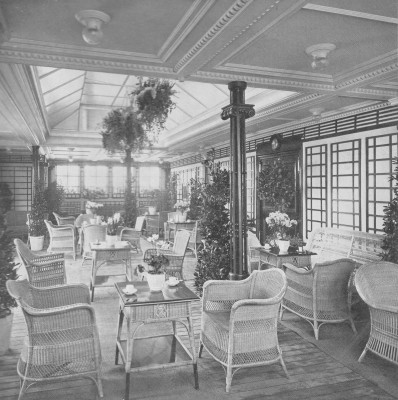
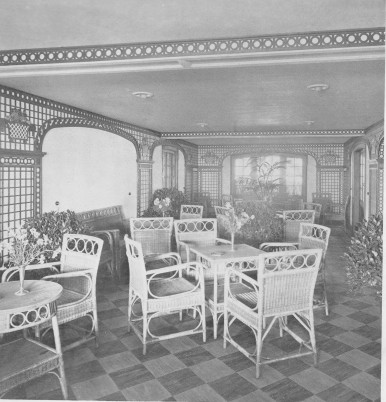
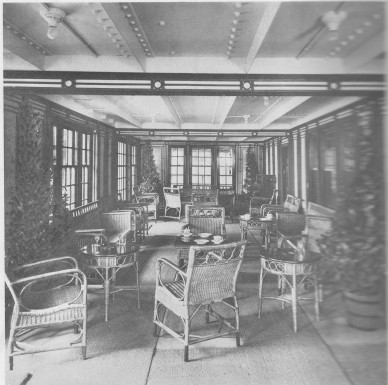
Their decorative DNA lived on in the QM2’s Winter Garden, but the Carinthia Lounge lacks any connection with the past beyond its name (the Cunard fleet had four separate Carinthias over the years). Although the space is named after the Carinthia that entered service in 1925, the decor doesn’t do much to evoke the feel of the 20s. On the contrary, it seems more reminiscent of the 50s. That’s not to say that it’s an ugly room; far from it. It just feels rather generic. Say what you will about the bird mural, but at least it was memorable.
However, most of the changes to the QM2 are to be welcomed. I’m particularly pleased that Cunard has decided to downsize the casino in order to add single-occupancy cabins. This is a wonderful development. For me, one of the biggest impediments to cruising is that the fares are based on double occupancy. My usual travel companions aren’t terribly interested in cruising, which means I’d have to either pay the exorbitant single occupancy surcharge (which can be 150-200% of the advertised fare) or allow the cruise line to match me with a cabinmate for the voyage. Neither option is particularly appealing, so I never considered cruising a viable vacation choice. Until now.
I’m also glad that King’s Court will be overhauled. It always seemed like a problematic space. When I was on board, it felt like a glamorous cafeteria, which seems a bit incongruous given the QM2’s reputation for luxury. To some extent, there’s not much Cunard can do about that. Any place where you collect your food from serving stations and carry it to a seating area to eat is going to feel like a cafeteria. I do think that the proposed changes are a step in the right direction, though. It won’t change the way people interact with the space, but it will make it more appealing.
One thing that surprised me is that G32, the ship’s nightclub, won’t be axed. It’s a bizarre place. Tucked away at the stern, you can only get to it by walking through the ballroom. It’s also tiny, and there’s not much room for dancing. When I poked my head in, I saw a bored DJ playing songs for an empty room while the bar staff huddled around the bar, chatting. Of course, with the average QM2 passenger being in their mid-60s, it’s hardly surprising that nobody’s interested in hitting the club, which makes one wonder why they’re keeping it at all.
All in all, I’m happy with the changes Cunard is making to the QM2. I think they’ll hold her in good stead as she sails through her second decade.




